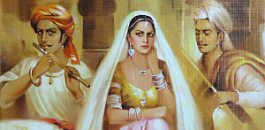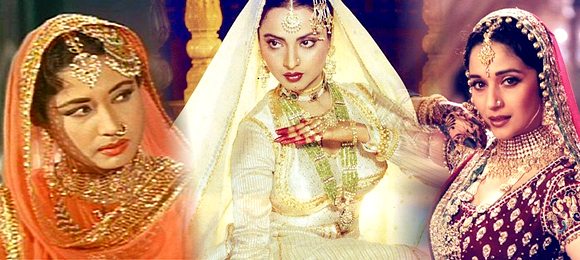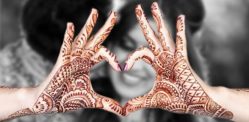Though courtesans were involved in sexual activities with the rich, their status was reduced to mere prostitution.
The life of a courtesan in India spans across centuries of rich heritage and the cosmetic change in society in India’s attitudes towards sexual needs of men.
Imagine a vast hall with the roof seemingly reaching the sky. The walls studded with intricate murals and carvings soaked in real gold leaves.
Huge mirrors and wall to wall Persian carpets, crystal chandeliers so vivid and vibrant that it seems the entire sky is engulfed in them.
Among all of this is a dainty petite figure of a woman sitting in the middle of that hall being the focus of thirsty glances of kings and courtiers alike. The men admiring her, and the women hidden behind a purdah aspiring to be her.
Yes, this was the golden era of the famous courtesans of India who have now unfortunately been reduced to ‘kothewalis’.
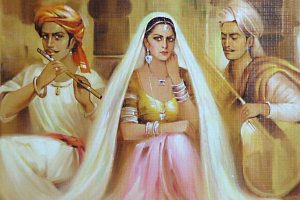
Come and let us indulge ourselves into the glorious past of these women whose charms and beauty were so blazing that it made even kings and emperors fall at their feet, and how this rapidly changed for the worse.
The courtesans of India did not emerge out of a sudden whim, the history of such women takes us back thousands of years. In fact, details of the Mahabharata and Ramayana state that courtesans existed even then. This section of women who were called courtesans had a precise job: of giving pleasure to the men of the court.
In contrast to the concepts that courtesans were a condemned section of the society, these women were in fact so rich and so politically active that they sometimes made hugely significant dents on Indian history.
The Mughals were very fond of such intellectual yet attractive women. The story of ‘Anarkali’ and ‘Salim’ is surprisingly not fiction.
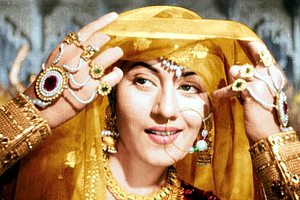
Not only Salim, but Aurangzeb was bedazzled by Moti Bai, Shah Jahan had Noor Begum, and there was Gauhar Jaan.
Indian history is full of women who were politically, intellectually, culturally involved in shaping history.
Historically speaking, courtesans were ‘devadasis’ or women who used to sing and dance for the presiding deity of the temple. These women were married to the presiding deity, but the kings and courtiers also had the pleasure to witness their art of poetry, singing and dancing.
In plain words though the ‘devadasis’ were married to the Lord, they often quenched the pleasures of the rich. Now comes a surprising fact. Can you imagine that all Indian classical dances like Bharatnatyam, Odissi, and Kathak are just residuary art forms left behind by these ‘devadasis’ or courtesans?
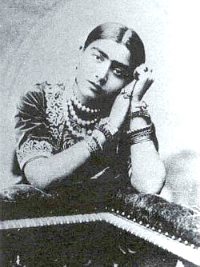
Today one may hear the term ‘kothewali’ and immediately club it together with a perception of woman with lowly character involved in prostitution.
This was not always so. It was the British who condemned the practice of ‘devadasis’, they bifurcated the princely kingdoms causing a loss of patronage for the courtesans.
For these reasons the courtesans, now called the ‘nautch girls’, were forced to become mere sex workers because they needed to feed themselves and their families.
These courtesans now started catering to the rich and poor simultaneously. The art and culture in their performances became significantly reduced to mere sexual acts and whatever culture of singing and dancing remained came under the canopy of ‘mujra’.
‘Mujrewali’ or ‘kothewali’ became generic terms for prostitutes. The thin line between the learned courtesans and lowly sex workers vanished. ‘Mujra’ became the trend. Incidentally, a ‘mujra’ when seen, has an uncanny resemblance with kathak, a classical dance form of India still common today.
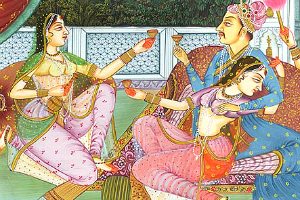
The era of the British Raj is rightly called the dark ages of these heavenly courtesans.
Following this period, there came the freedom movement which acted as a renaissance for the courtesans. These women who were now just mujra dancers and sex workers were given the opportunity to work in films and music industry.
People like Rukmini Devi, Kelucharan Mohapatra, and Madame Meneka refined the ‘devadasi’ dance and made it suitable to be performed on stage as classical dance and music set to suit the aesthetic conservative approach of the masses.
The first generation of Bollywood actresses were courtesans in their own sense. This is because performing on screen required singing and dancing which they were already proficient in.
Moreover, the stigma associated with performing for films considered lowly and dirty job didn’t matter to the courtesans as they had no worries of family or in-laws. The oldest existing gramophone record of an Indian singer is that of Gauhar Jaan who was one of the living original and authentic courtesans.
Today we can watch item numbers like ‘Kajra Re’ (Bunty Aur Babli, 2005), ‘Chikni Chameli’ (Agneepath, 2012), and ‘Munni Badnaam Hui’ (Dabangg, 2010) being performed by the reigning beauty queens of Bollywood.
But it is nothing more than what once the courtesans did in a private hall for the king. Think of the word courtesan and a vivid image of Rekha performing mujra on ‘Dil Cheez Kya Hai’ (Umrao Jaan, 1981) is what we all stumble onto.
From ‘Baithak’ style performance to the silver screen, the art of being a courtesan now has a mass appeal. And what remains of the heavenly nymphs of the Indian courtesans is ‘mujra’ with its broken hip hop jerks amalgamated with kathak movements and item numbers played by DJ’s at weddings.
The golden era of the Indian courtesans is now gone but the culture of classical dance and music which they gifted to us must be preserved and their story must be shared and spread far and wide.



















































